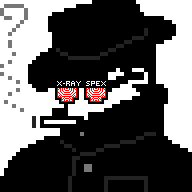bubstance
Non-binary computer witch.
ネットワーク内部から来ています。
¡ACHTUNG!
May contain thoughts and opinions
Viewer digression is advised
http://9p.sdf.org/~bubstance/
mailto:[email protected]
openpgp4fpr:5e057c319b634f422db8267189ba712e2779375b
- 0 Posts
- 17 Comments
Plan 9 is still actively developed in the form of 9front; updates and new features trickle down to 9legacy from there.
The “original” Plan 9—meaning stock 4th Edition—is more of a museum piece at this point, though, yes.
I can say that, at least in the Southwestern US, our local Kroger stores all use Linux of some variety at their self-checkouts. I’ve seen the same as above: mostly CentOS and Rocky.
Sure, basically any Debian-based distro should have
gdebiin its repos.

 2·3 months ago
2·3 months agoIt used to be that everyone in the Boot Camp got their own VM that was wiped each season, but recently everything was migrated to a single installation that doesn’t reset and everyone uses.
In short: now you get a permanent account.
And yes, SDF itself is NetBSD-based—the largest single installation as well as a primary testing environment, if I’m not mistaken.

 2·3 months ago
2·3 months agoPython 2.5.1 was distributed as part of 9front back when it used
hg, but it was ultimately removed from the base system once we switched over togit9. 9legacy still packages binaries, however; they’re up to 2.7.6 for Python and 2.9.2 for Mercurial.I never bother with venti/fossil, honestly. I’m more of a
cwfskind of person, but Ori’sgefshas been attracting my attention lately.

 8·3 months ago
8·3 months agoIf you ever want to just poke around a Plan 9 system, SDF Public Access UNIX System offers an ongoing Plan 9 Boot Camp.
Stop by and join us in
comsometime!

 5·3 months ago
5·3 months agoAdditionally, for those that may want a Plan 9 that’s being actively developed and will actually work on modern hardware:
There’s also 9legacy, which is basically “classic” Plan 9 with some patches from 9front.

 8·3 months ago
8·3 months agoI use it because it’s truly a “complete system” in a way that Linux and even the BSDs are not—every program is an example in itself and it comes with a ton of various scratch-built utilities that you don’t usually find as part of a typical Linux distro. Stuff like a basic torrent or IRC client just sort of fall out of the way Plan 9 is organized and implemented.
It also provides me with a distraction-free environment and a set of tools that I enjoy using, even if some aspects of Plan 9 as, say, a laptop daily driver are inconvenient or awkward. It really is better suited for networked computing.
I was pretty much sold from first contact because Plan 9 is the way that I feel best matches what I’ve always wanted from my machines: a simple grid of networked appliances where I can route the various resources and hardware in whatever way I require.

 8·3 months ago
8·3 months ago

 2·3 months ago
2·3 months agoIn
#cat-v? Not regularly. I mostly hang out in gridchat with a handful of the 9front people.

 60·3 months ago
60·3 months agoThere are dozens of us! Dozens!

 12·3 months ago
12·3 months agoClosest thing for
bashwould beble.sh.

 25·5 months ago
25·5 months agoIt sounds like Gentoo is literally exactly what you want.
I am currently not using gentoo, and because the packages in its default repos are only updated when necessary, and the break-my-gentoo repo is more of a joke than an actual replacement for arch.
I’m sorry, but I am genuinely confused here.
Gentoo can be both stable and bleeding edge and allows you to mix and match on a per-package basis.
Does setting
ACCEPT_KEYWORDS="~amd64"globally not make things bleeding edge enough for you? Grab*-9999packages instead.


You are correct and this can be seen in some of the old AT&T demos from the '80s floating around on YouTube. There is even a chart that specifically labels a directory like
/usr/bwkas the user’s home.Plan 9 also uses this old convention; users live under
/usrand there is no/home.